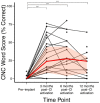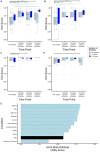Cochlear implantation in unilateral hearing loss: impact of short- to medium-term auditory deprivation
- PMID: 37877013
- PMCID: PMC10591100
- DOI: 10.3389/fnins.2023.1247269
Cochlear implantation in unilateral hearing loss: impact of short- to medium-term auditory deprivation
Abstract
Introduction: Single sided deafness (SSD) results in profound cortical reorganization that presents clinically with a significant impact on sound localization and speech comprehension. Cochlear implantation (CI) has been approved for two manufacturers' devices in the United States to restore bilateral function in SSD patients with up to 10 years of auditory deprivation. However, there is great variability in auditory performance and it remains unclear how auditory deprivation affects CI benefits within this 10-year window. This prospective study explores how measured auditory performance relates to real-world experience and device use in a cohort of SSD-CI subjects who have between 0 and 10 years of auditory deprivation.
Methods: Subjects were assessed before implantation and 3-, 6-, and 12-months post-CI activation via Consonant-Nucleus-Consonant (CNC) word recognition and Arizona Biomedical Institute (AzBio) sentence recognition in varying spatial speech and noise presentations that simulate head shadow, squelch, and summation effects (S0N0, SSSDNNH, SNHNSSD; 0 = front, SSD = impacted ear, NH = normal hearing ear). Patient-centered assessments were performed using Tinnitus Handicap Inventory (THI), Spatial Hearing Questionnaire (SHQ), and Health Utility Index Mark 3 (HUI3). Device use data was acquired from manufacturer software. Further subgroup analysis was performed on data stratified by <5 years and 5-10 years duration of deafness.
Results: In the SSD ear, median (IQR) CNC word scores pre-implant and at 3-, 6-, and 12-months post-implant were 0% (0-0%), 24% (8-44%), 28% (4-44%), and 18% (7-33%), respectively. At 6 months post-activation, AzBio scores in S0N0 and SSSDNNH configurations (n = 25) demonstrated statistically significant increases in performance by 5% (p = 0.03) and 20% (p = 0.005), respectively. The median HUI3 score was 0.56 pre-implant, lower than scores for common conditions such as anxiety (0.68) and diabetes (0.77), and comparable to stroke (0.58). Scores improved to 0.83 (0.71-0.91) by 3 months post-activation. These audiologic and subjective benefits were observed even in patients with longer durations of deafness.
Discussion: By merging CI-associated changes in objective and patient-centered measures of auditory function, our findings implicate central mechanisms of auditory compensation and adaptation critical in auditory performance after SSD-CI and quantify the extent to which they affect the real-world experience reported by individuals.
Keywords: auditory deprivation; cochlear implant; health utility; single-sided deafness; spatial hearing; speech perception.
Copyright © 2023 Ullah, Cevallos, Shen, Carver, Dunham, Marsiglia, Yeagle, Della Santina, Bowditch and Sun.
Conflict of interest statement
The authors declare that the research was conducted in the absence of any commercial or financial relationships that could be construed as a potential conflict of interest.
Figures






References
-
- Agterberg M. J. H., Hol M. K. S., Van M. M., Wanrooij A. J., Opstal V., Snik A. F. M. (2014). Single-sided deafness and directional hearing: contribution of spectral cues and high-frequency hearing loss in the hearing ear. Front. Neurosci. 8:188. doi: 10.3389/fnins.2014.00188, PMID: - DOI - PMC - PubMed
LinkOut - more resources
Full Text Sources

